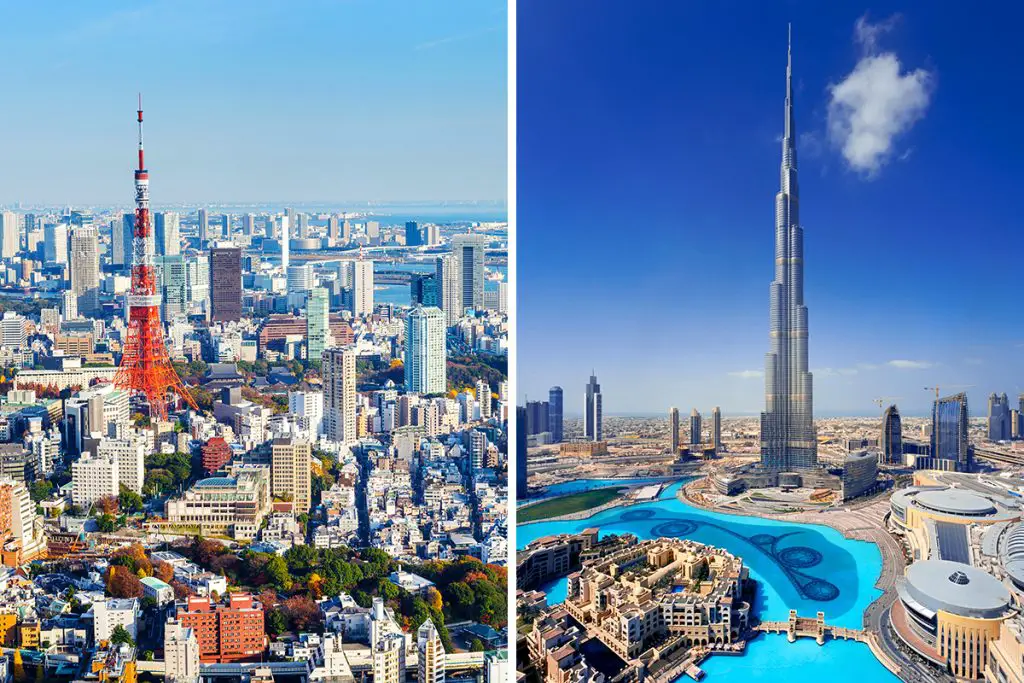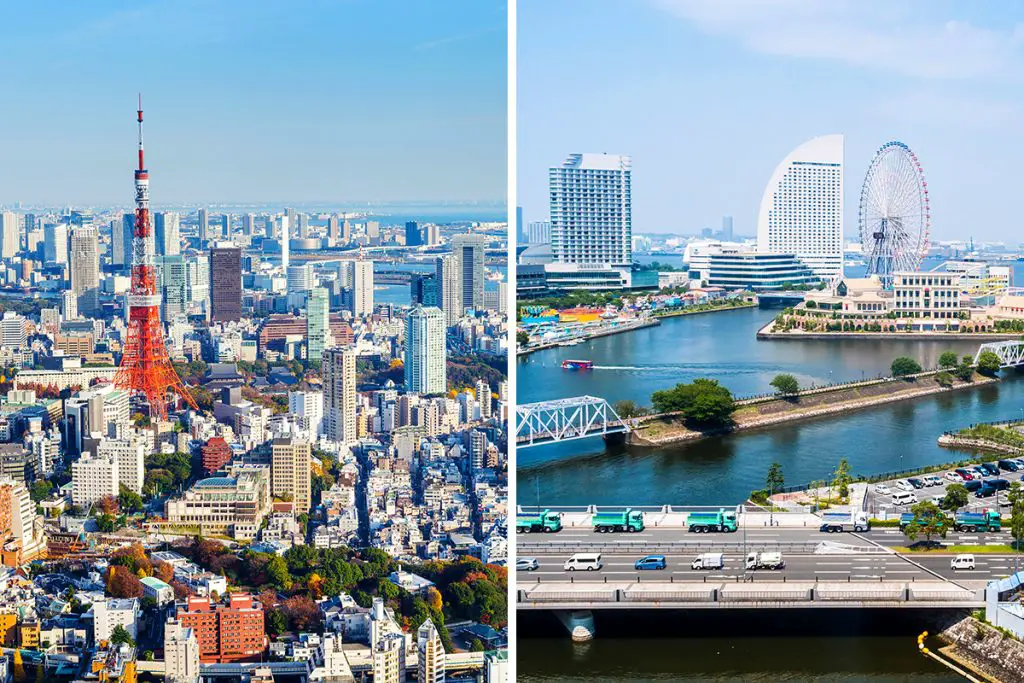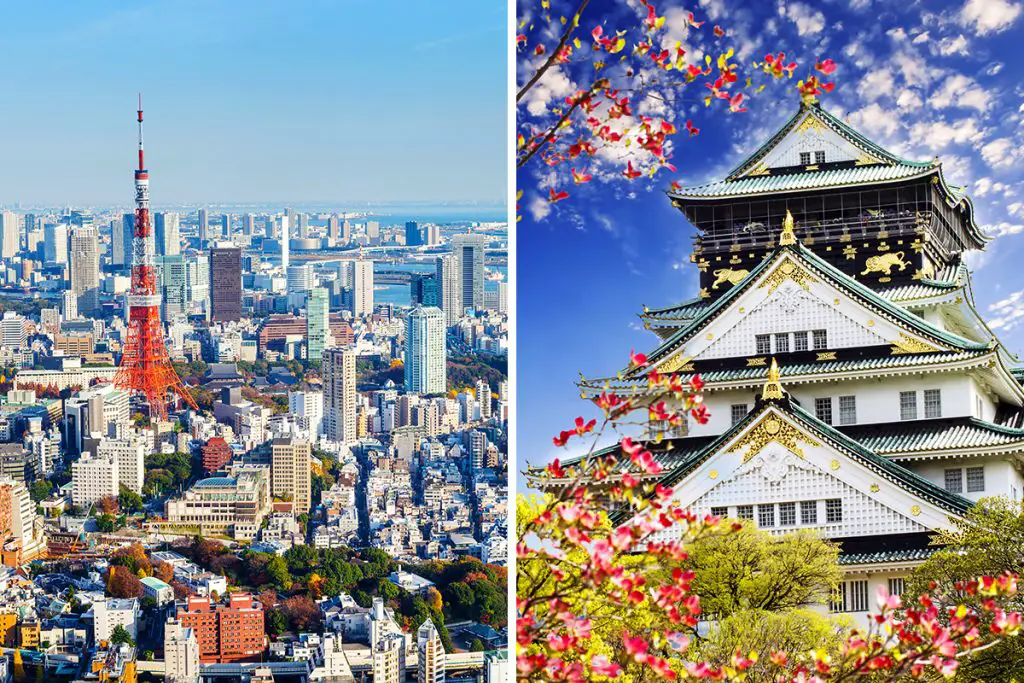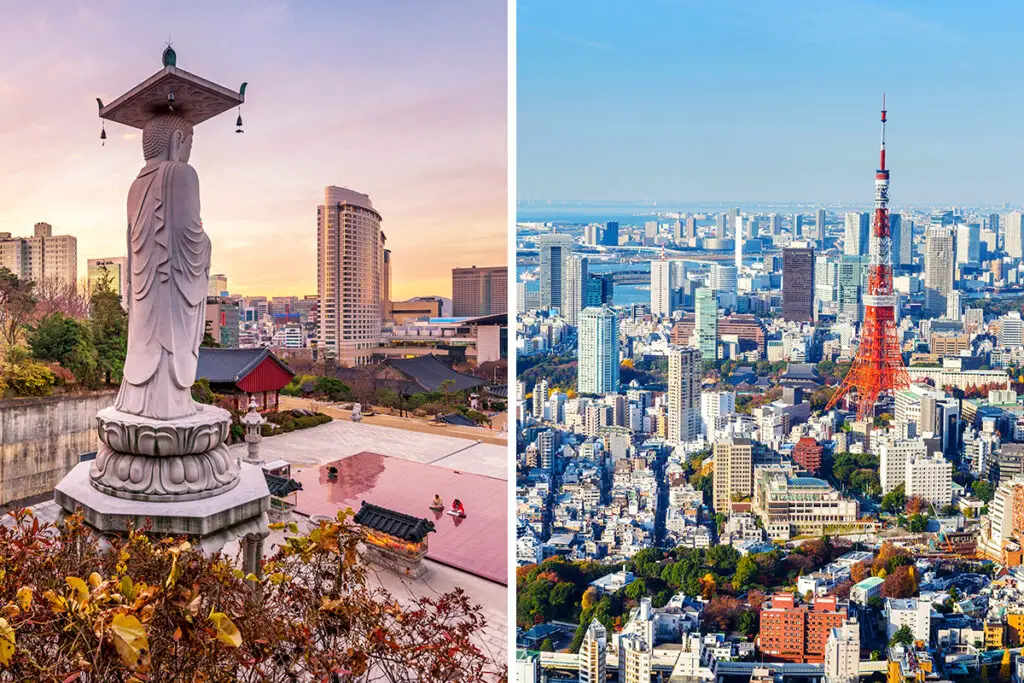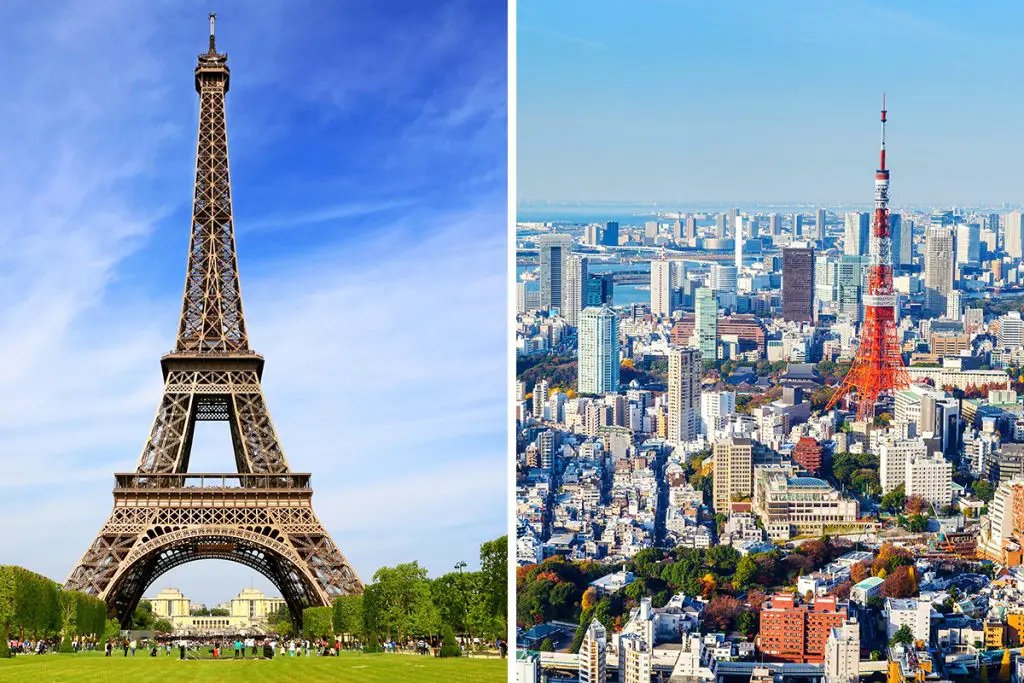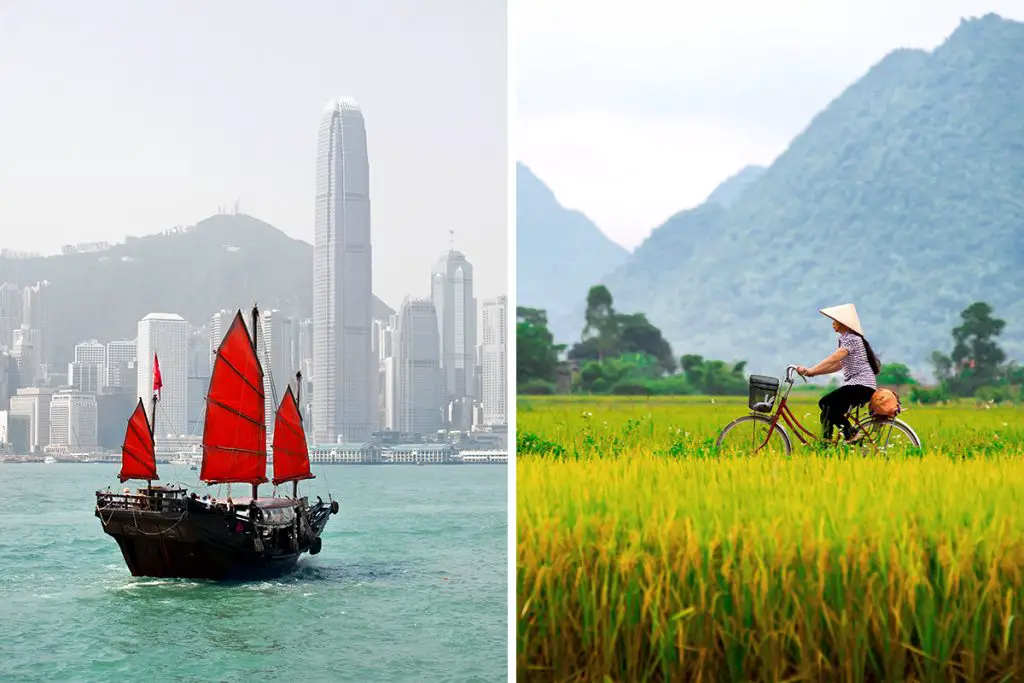Each country promises a unique journey filled with captivating stories and deep-rooted traditions. Are you ready to unravel the tapestry of time that each nation offers? Keep reading to decide which place will leave an indelible mark on your soul.
History & Culture
Starting off, let’s talk about the history and culture of Japan and Vietnam. These nations are like massive, colorful mosaics, each tile representing a bit of their past and way of life.
First up, Japan. Here, tradition and modernity exist side by side. From the ancient art of tea ceremonies to the futuristic technology of robots, Japan’s culture is a blend of the old and the new. It’s like taking a time machine where you see samurais and tech moguls all in one frame! They have their own script and language, and customs that go back thousands of years.
Next, let’s hop over to Vietnam. This country has also seen its share of ancient empires and modern-day struggles. Vietnam is a fusion of multiple influences, including Chinese, French, and American. Yet, it maintains a unique identity that’s all its own. Think of it as a colorful quilt made from different types of fabric but all stitched together tightly.
But how do they differ? Well, Japan’s cultural identity is more inward-focused. They’ve kept foreign influences at bay for long periods in their history.
Vietnam, on the other hand, has absorbed more external influences due to its complex past, including colonization and war. So, in Vietnam, you might see a mix of Eastern and Western culture, whereas in Japan, the traditions are more purely Japanese.
No matter where you go, you’re stepping into a world rich in history and culture. Japan offers a more homogeneous experience, deeply rooted in its own traditions. Vietnam provides a diverse cultural landscape, molded by a variety of influences. Both are incredible in their own way, and either will offer you a fascinating plunge into a world unlike your own.
So, the question remains: Are you drawn to the introspective and deeply rooted culture of Japan or the blended and resilient culture of Vietnam? It’s a difficult choice, but one that promises a rich, fulfilling experience.
Attractions & Activities
When you’re planning a trip to either Japan or Vietnam, one of the most thrilling aspects to consider is the range of attractions and activities each place offers. Both countries give you a playground of diverse experiences. But what exactly sets them apart? Let’s delve into the specifics.
Japan is a dream for history buffs and tech lovers alike. Imagine visiting Kyoto, where you can walk among ancient temples and witness the beauty of cherry blossoms in the spring. If you’re into hiking, you won’t want to miss a trek up Mount Fuji, the country’s tallest peak at 3,776 meters (12,389 feet).
Or maybe the bustling streets of Tokyo, filled with unique museums and parks, is more your speed.
Switch gears and you find yourself in Vietnam, a haven for adventure enthusiasts and nature seekers. Imagine cruising through Ha Long Bay, taking in the stunning karst formations that jut out of the water.
Or how about exploring the Phong Nha-Ke Bang National Park, with its ancient caves and underground rivers? Don’t forget the breathtaking terraced rice fields in Sapa, where you can trek and capture Instagram-worthy photos.
Yet there are differences. Japan’s attractions are often more polished, focusing on both historical preservation and modern innovation. In contrast, Vietnam offers raw beauty and adventure. While Japan offers you meticulously crafted gardens and tech-savvy cities, Vietnam presents untamed natural landscapes and outdoor adventures like kayaking and trekking.
To sum it up, both countries offer a feast for your senses and a boost to your adventurous spirit. Japan entices you with a blend of the past and future, a mix of natural beauty and technological wonder. Vietnam, on the other hand, calls to the wild side in you, offering raw landscapes and heart-pounding activities. The choice comes down to what sort of canvas you want to paint your experiences on: Is it the refined elegance of Japan or the untamed vibrancy of Vietnam?
Beaches
Let’s shift our focus to beaches, shall we? Japan and Vietnam offer quite contrasting beach experiences. Whether you’re into surfing or simply lying on the sand, you’ve got some thinking to do.
Japan might surprise you with its beaches. Think Okinawa, which is almost 1,600 kilometers (around 994 miles) from Tokyo. Okinawa offers beautiful coral reefs perfect for diving and snorkeling. The waters here are crystal clear, and the marine life is vibrant. But don’t expect wide stretches of sand; Japanese beaches are often smaller but pristine.
Vietnam’s coast stretches for about 3,260 kilometers (approximately 2,025 miles), offering a range of beach experiences. You can find busy beaches close to cities as well as secluded ones like Bai Dai in Phu Quoc. The water in Vietnam is generally warm, making it great for swimming and water sports.
In terms of differences, Japan’s beaches offer a quieter, almost meditative atmosphere, suited for those who wish to escape and rejuvenate. The beaches in Vietnam are often livelier, catering to those who like a mix of relaxation and mild adventure, like jet-skiing or parasailing.
So, to sum it up, both countries offer stunning beaches but with very different vibes. Japan provides an intimate, peaceful experience with a focus on natural beauty and marine life. Vietnam offers a more dynamic beach scene, complete with water sports and larger crowds. What’s it going to be? A tranquil retreat in Japan or an energetic escape in Vietnam?
Eating, Drinking & Nightlife
Hungry for more than just adventure? Japan and Vietnam both serve up unique culinary delights, thirst-quenching drinks, and an electrifying nightlife. Yet, they offer very different flavors and experiences in each category. Let’s bite into the details.
Japan is famous for its sushi, sashimi, and ramen. Imagine sitting down at a sushi bar in Tokyo where a chef crafts each piece with expert precision. Japanese cuisine is an art form, focused on balance, aesthetics, and seasonal ingredients. Your taste buds will thank you for the explosion of flavors.
Switch to Vietnam, and the food scene becomes a bustling symphony of street vendors, markets, and family-run eateries. Pho, banh mi, and spring rolls are ubiquitous. The flavors are bold, with ample use of herbs, and meals often come with a variety of dipping sauces. It’s comfort food that dances on your tongue.
Now, let’s talk drinks. In Japan, you must try sake, a traditional rice wine served either warm or cold. Whiskey is also popular, thanks to a burgeoning craft scene. In Vietnam, bia hoi, or fresh beer, is a local favorite, often consumed at roadside stalls. For something non-alcoholic, Vietnamese iced coffee is a strong, sweet pick-me-up.
As for nightlife, Tokyo is the king of bright lights and endless entertainment options. From karaoke bars to high-energy clubs, there’s something for everyone. Vietnam’s nightlife is more laid-back but still fun. Cities like Ho Chi Minh offer a range of rooftop bars and open-air bistros, where you can enjoy the evening breeze.
To sum it up, Japan offers a sophisticated dining experience, complete with world-class drinks and a bustling nightlife. Vietnam offers a more rustic but equally memorable culinary journey paired with simple drinks and a relaxed nightlife. So, will it be sushi or pho, sake or bia hoi, a night in Tokyo or a rooftop in Vietnam?
Shopping
If you’re the type who loves bringing home unique finds, you’ll want to know about the shopping scenes in Japan and Vietnam. Both countries have plenty to offer but with distinct styles and specialties.
In Japan, shopping ranges from high-end fashion districts like Ginza in Tokyo to ancient markets like Nishiki in Kyoto. Think designer brands, cutting-edge electronics, and artisanal crafts. You can also find uniquely Japanese items like kimonos, tea sets, and beautifully crafted knives.
Vietnam has its own set of treasures, often at bargain prices. Markets like Ben Thanh in Ho Chi Minh City or Dong Xuan in Hanoi are buzzing with activity. You’ll find hand-woven textiles, bamboo products, and intricate lacquerware. Don’t forget to haggle; it’s part of the fun!
One major difference is the ambiance. Japanese shopping often feels like an experience of refined elegance, where even the packaging is an art. Vietnamese markets are the opposite — lively, bustling, and slightly chaotic, but in the best possible way.
Whether you prefer the upscale boutiques and department stores of Japan or the energetic markets and local crafts of Vietnam, both countries offer unique shopping experiences that you’ll remember long after your trip.
So, what catches your eye? Will it be the sleek sophistication of Japan’s shopping districts or the vibrant, bustling markets of Vietnam? Your suitcase is waiting!
Accommodation
When it comes to settling down for the night, both Japan and Vietnam have diverse lodging options to fit your style and budget. Whether you’re looking for luxury or a simple place to rest, each destination has its own flavor of hospitality.
In Japan, you can choose from luxury hotels in bustling districts like Shibuya and Shinjuku. If you’re more inclined towards tradition, try a “ryokan,” a Japanese-style inn complete with tatami mat rooms and communal hot baths. For the budget-conscious, capsule hotels offer a unique but tiny space, sometimes no larger than 2 square meters (approximately 21 square feet).
Vietnam also has a range of accommodation options, from five-star resorts in Da Nang to homestays in the Mekong Delta. If you’re on a tight budget, hostels are abundant, especially in cities like Hanoi and Ho Chi Minh City. Or for a uniquely Vietnamese experience, consider staying in a stilt house in the mountainous regions.
In Japan, service is meticulously attentive, often featuring multiple amenities like high-speed internet, saunas, and even robots in some high-tech hotels. In Vietnam, expect warm hospitality and local recommendations, particularly in family-run establishments.
To sum it up, Japan tends to offer more in terms of modern amenities and luxury, while Vietnam provides a range of options that often include a closer look at the local culture. So, what’s more your style—a ryokan or a stilt house, a capsule or a hostel?
Family-Friendliness & Children’s Activities
Traveling with the family? You’ll be happy to know that both Japan and Vietnam have loads of activities that are fun for kids and adults alike. Let’s dig into the specifics.
In Japan, think about visits to interactive museums like the Railway Museum in Saitama or the Ghibli Museum in Tokyo. Animal cafes featuring cats, owls, or even hedgehogs are also big hits with kids. And let’s not forget Japan’s obsession with everything cute, or “kawaii,” which translates into an array of colorful and interactive experiences that kids love.
Vietnam, on the other hand, offers a more outdoorsy experience for families. Kayaking in Ha Long Bay, cycling in the countryside, and animal spotting in Cuc Phuong National Park are just some of the activities that families can enjoy together. Traditional puppet shows and kite flying are other cultural activities that kids might find fascinating.
Both countries prioritize safety and cleanliness, making them great destinations for families. Japan’s public spaces, including children’s attractions, are extremely clean and well-maintained. Vietnam also focuses on safety, particularly in tourist areas, ensuring families can explore with peace of mind.
In summary, Japan offers a tech-savvy, clean, and cute-infused environment that can fascinate children and adults. Vietnam leans more towards nature-based, interactive experiences that allow families to bond outdoors. Where will your family find its joy—the technology-rich avenues of Japan or the natural playgrounds of Vietnam?
Getting There & Getting Around
So, you’re sold on visiting either Japan or Vietnam, but how do you get there and navigate through these captivating countries? Let’s dive into the essentials.
Japan is accessible via numerous international airports, with Narita and Haneda airports in Tokyo being the most common entry points. Direct flights from major cities around the world make it relatively easy to get there. Vietnam is also well-connected, with Tan Son Nhat in Ho Chi Minh City and Noi Bai in Hanoi serving as major international gateways.
Now, let’s talk about getting around. Japan has one of the most efficient public transportation systems in the world. Trains run like clockwork and cover vast distances, with the Shinkansen, or bullet trains, reaching speeds of up to 320 km/h (approximately 199 mph). Buses and subways are also plentiful and reliable.
In Vietnam, public buses and taxis are the most common modes of transport in cities. For longer distances, domestic flights and sleeper buses are popular options.
Japan’s system is known for its punctuality and cleanliness but can be a bit pricey. Vietnam’s transport is more budget-friendly but less predictable in terms of timing and comfort.
So, whether it’s the meticulous efficiency of Japan’s transit system or the more laissez-faire but budget-friendly options in Vietnam, both countries have their own set of advantages and quirks when it comes to getting there and getting around. Which suits your travel style more—a perfectly timed train or a leisurely bus ride?
Weather
When it comes to vacation, weather can make or break your experience. Let’s talk about what kind of skies and temperatures you can expect in Japan and Vietnam.
In Japan, you can experience all four seasons. Winters, especially from December to February, are cold with temperatures ranging from 30-45°F (about -1 to 7°C). Summers, particularly in July and August, can be hot and humid, with temperatures often hitting 85-95°F (29-35°C). If you prefer cherry blossoms, consider visiting in April.
Vietnam has a tropical climate. The south remains warm year-round, averaging 77-95°F (25-35°C), while the north experiences a cooler winter from November to April with temperatures around 60-75°F (15-24°C). The rainy season varies, but it typically spans from May to October.
Each country has unique weather perks. Japan offers the chance to see beautiful cherry blossoms or autumn leaves. In Vietnam, you can enjoy the beaches practically year-round, except during the rainy season when heavy showers are frequent.
In summary, Japan offers you a taste of all four seasons, each with its unique beauty. Vietnam, on the other hand, leans toward tropical warmth and has a distinct rainy season. So, would you rather experience cherry blossoms in spring or bask on a sunlit beach?
Safety
Safety is a top priority for any traveler. Both Japan and Vietnam have reputations for being relatively safe, but there are differences to consider.
Japan is often lauded for its low crime rate. Violent crime is rare, and petty crime like pickpocketing is not common either. Public spaces are well-lit, and police are trustworthy and approachable.
Vietnam also ranks as a safe travel destination. Petty crimes like bag-snatching can occur, especially in busy tourist areas, but they are generally infrequent. It’s advisable to be cautious in crowded places.
Unique to Japan, natural disasters like earthquakes and typhoons can occur, so it’s important to be aware and prepared. Vietnam faces its own natural challenges like flooding during the rainy season.
To summarize, both countries are safe but come with their own sets of challenges. Japan offers an incredibly low crime environment but poses risks in terms of natural disasters. Vietnam is generally safe but requires a bit more vigilance in busy areas. So, do you value the peace of mind that comes with Japan’s low crime rate, or do you feel you can navigate Vietnam’s busy streets smartly?
Cost
When it comes to budgeting for your trip, Japan and Vietnam offer very different landscapes. Let’s look at some specifics on food, lodging, and transportation.
Japan is on the pricier side. A meal at a mid-range restaurant can cost around 2,000 JPY (approximately 18 USD). A night in a three-star hotel ranges from 170 USD. Transportation is also costly; a single ticket for the Tokyo Metro costs 170 JPY (about 1.5 USD).
Vietnam is much more budget-friendly. A decent meal can cost you around 100,000 VND (approximately 4 USD), and a night in a three-star hotel would be about 120 USD. For transportation, a single bus ticket in Hanoi or Ho Chi Minh City costs around 7,000 VND (around 0.3 USD).
To sum it up, Japan is a destination where you might have to dig deeper into your pockets, especially for food and accommodation. On the flip side, Vietnam offers a more budget-friendly experience without skimping on quality. Which factors more into your travel plans—luxury or affordability?
Which Is Better – Japan or Vietnam?
Choosing between Japan and Vietnam for your next adventure is no easy task. Each country comes with its own rich tapestry of experiences that make it unique and appealing. Let’s recap what each destination has to offer based on various aspects.
For history and culture buffs, Japan offers the allure of ancient traditions seamlessly blended with modern life. Vietnam counters with its own compelling history and local traditions that have been shaped by a variety of influences over the centuries.
Both countries offer a deep dive into unique cultural experiences, but if old-world charm infused with modernity fascinates you, Japan might just tip the scale.
In terms of attractions and activities, Japan is abundant with historic temples, high-tech attractions, and scenic landscapes. Vietnam offers its own rich array of activities, including ancient ruins and unique mountainous terrains.
For those who like a mix of the old and the new, Japan could be more up your alley, while Vietnam would be a great choice for the adventurer in you.
When it comes to beaches, Japan’s are varied and picturesque, especially those in Okinawa. Vietnam boasts its own beautiful coastlines, particularly in places like Da Nang and Phu Quoc. If a beach-centric vacation is what you’re after, Vietnam might be your best bet.
As for eating, drinking, and nightlife, both countries have diverse offerings. Japan is more on the luxurious side with its world-renowned cuisine and unique nightlife. Vietnam offers a more rustic but equally thrilling culinary experience.
Japan might be your destination if you’re looking for fine dining and exotic cocktails, while Vietnam is the place for street food lovers and night markets.
Accommodation in Japan tends to be pricier but offers unique experiences like ryokans and capsule hotels. Vietnam provides more budget-friendly options without compromising on comfort. Japan is the go-to destination if you’re looking for a luxurious stay, and Vietnam fits the bill if you’re looking to save money.
So, when is it better to choose one destination over the other? Opt for Japan if you’re interested in a diverse range of modern and traditional experiences, and if budget isn’t a significant concern. On the other hand, Vietnam is your destination if you’re looking for an adventurous journey that is kind on your wallet but rich in experience. Whatever you choose, both countries promise an unforgettable journey.


